Are you eager to uncover the latest insights into landing page statistics? Well, you're in for a treat.
In July 2023, we surveyed 101 seasoned marketing and advertising experts from various corners of the United States to learn more about the latest trends for landing pages.
Landing pages, often hailed as the gateway to online success, play a pivotal role in today‘s digital landscape. They are the crucial bridges that connect potential customers to your brand’s offerings.
A well-crafted landing page can differentiate between a fleeting visitor and a devoted customer.
In this article, we‘ll not only uncover the invaluable insights gleaned from these industry leaders but also highlight the immense value that a strategically optimized landing page can bring to your business. Let’s dive in.
16 Stats That Make a Case for Landing Pages
1. The average landing page conversion rate across all industries is 5.89%.
10% is the benchmark for a good conversion rate. To hit this mark, you must create landing pages that benefit you and your target audience.
Whether you sell SaaS or clothing, a higher conversion rate from landing pages means a longer list of leads to nurture into paying customers.
2. 43.6% of marketers report generating leads as their goal, while 33.7% say direct customer purchase is their top priority.If you’re in either category, landing pages can be a valuable element of your marketing strategy. You can use them to generate leads, increase customer acquisition, and get free or paid subscribers.
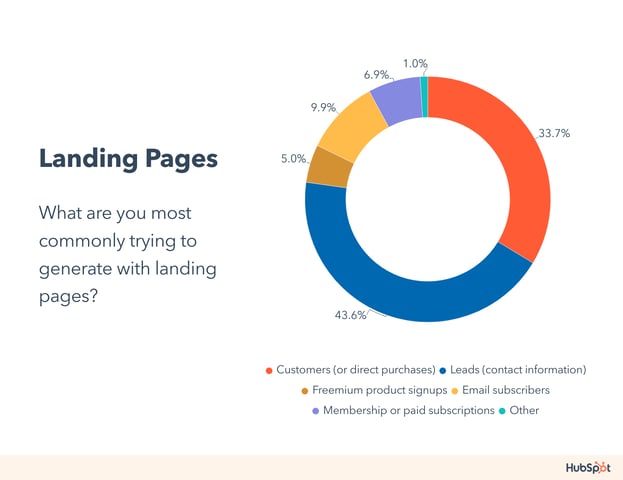
3. 33.7% of marketers see higher conversion rates in 2023 than in 2022.
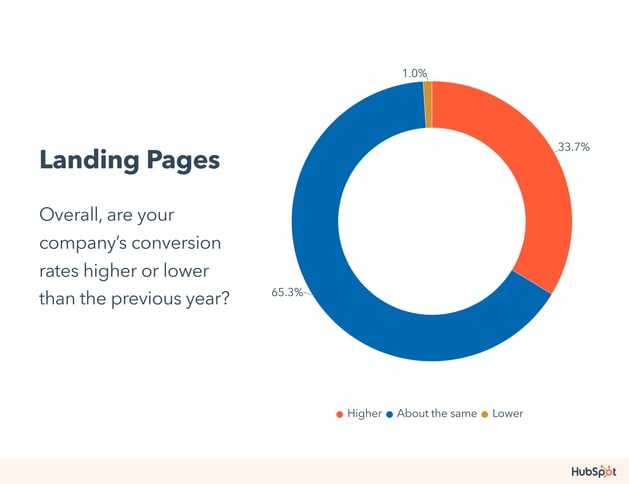
Our survey shows landing pages that convey positive emotions can help you get higher conversion rates.
That doesn’t mean you should ditch negative emotions like sadness and anger. When using emotions in marketing, consider your business and the goal of the landing page.
For instance, a donations landing page doesn’t have to convey happiness. It can be between happy and sad, causing the audience to empathize, connect, and give to the cause.
4. Marketers drive traffic to landing pages with multiple tactics.
3% of the marketers we surveyed didn’t have a landing page promotion strategy, but the others do. Here are the tactics they use:
- 7.9% — link building.
- 32.7% — paid advertising.
- 43.6% — email marketing.
- 5.9% — podcast promotion.
- 13.9% — YouTube promotion.
- 51.5% — social media promotion.
- 28.7% — Internal links in blog posts.
- 35.6% — search engine optimization.
- 17.8% — Partner/affiliate marketing.
- 20.8% — CTAs and banner advertisements on the website.
5. 38.6% of marketers say video is the #1 landing page element that impacts conversion.
If you already use video in your marketing, incorporating it into your landing page strategy can help you increase conversion rates.
In fact, 9 out of 10 people want companies to create more videos in 2023 — making videos an excellent tool for brand awareness and lead generation.
.
6. 30.7% of marketers say the ideal number of questions on a landing page form to get the best conversions is four.
There's no one-size-fits-all for the number of questions to ask on your landing page form.
In a different study of e-commerce brands, Omnisend found that the highest number of converting form fields is 3, with an average conversion rate of 10%.
The most popular combinations use email address and name (7%) and email address and birthdate (5.7%).
While three questions work for some, two could work for you. So, experiment to find what works. At HubSpot, creating multi-page forms is a form optimization strategy that works for us.
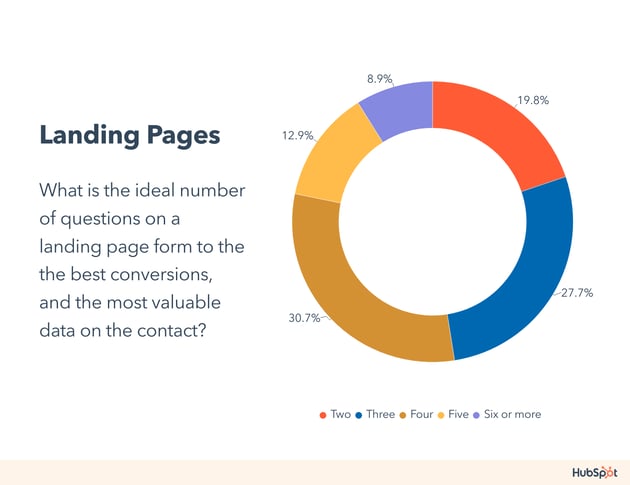
7. 10.9% of marketers report only the name and email are essential for a landing page form.
Other marketers collect information like role, company size, location, years of experience, phone number, company address, contact location, and the company’s industry.
8. 6.9% of the surveyed marketers use HubSpot to design landing pages.
Marketers use multiple content management systems to design their landing pages. When choosing one, ensure it’s versatile to address your needs.
9. Landing pages are the least popular type of signup form, but they have the highest conversion rate (23%).
Using landing pages to get customer contact information for lead nurturing will likely increase conversions.
10. Businesses using optimization software for their landing pages see an average conversion lift of 30%.
While optimization is always an essential factor for generating traffic, using optimization tools for your landing page strategy is valuable for increasing conversions.
11. Addressing buyer fears on landing pages can increase conversion rates by 80%.
Marcus Sheridan, a keynote speaker at Inbound 2019, shared an experiment he ran about customer fears. He found that addressing fears like email spam or personal data use on his landing pages increased his form conversion rate.
If your landing pages aren’t converting much, consider using Sheridan’s strategy. Be upfront with consumers about what will come from completing forms on your landing pages.
12. Personalized CTAs convert 202% better than default versions.
Consumers prefer personalization because it ensures they aren’t overloaded with irrelevant information that doesn’t interest them. Given this, using personalized and targeted CTAs in your landing pages will likely increase your conversion rates.
13. 55% of top landing page submissions on the HubSpot blog came from ebook offers.
If you have a blog or website that wants to distribute long-form instructional content, offering ebooks on your landing pages can help increase your business conversion rates.
14. Portent says pages that load in one second convert 3x higher than those that load in 5 seconds.
Customers won’t stick around if your landing page takes forever to load. So, ensure you do everything to improve your page speed.
15. The cost of creating one landing page is between $75 to $3000.
What affects your cost of creating a landing page depends on several factors. Are you working with an in-house creator or outsourcing to a freelancer or company? Is the landing page simple or complex? Do you require a landing page design?
16. Landing pages have the best signup rates.
Compared to popups, signup boxes, and wheels of fortune, landing pages have the best signup rates at 23%.
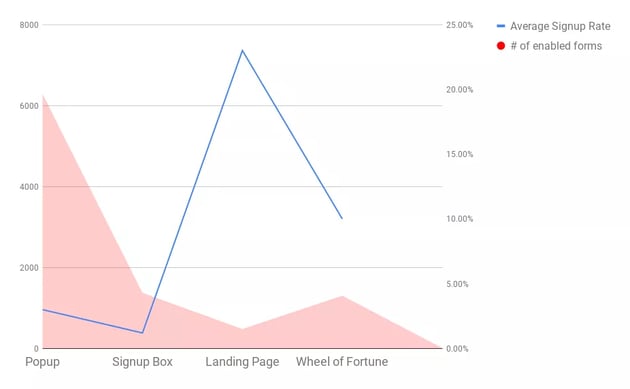 The interesting part? Popups make up about 66% of all signup forms. Compare that to landing pages that make up 5.1% of all signup forms, and what you see is an opportunity to create more landing pages and maximize conversions.
The interesting part? Popups make up about 66% of all signup forms. Compare that to landing pages that make up 5.1% of all signup forms, and what you see is an opportunity to create more landing pages and maximize conversions.
Landing Pages are a Valuable Piece of Your Marketing Strategy
Considering the above stats, marketers who create landing pages that build trust with page visitors, provide valuable information, and use different content types see higher conversion rates.
Whether you already use them and aren’t obtaining the results you desire or you’re new to landing pages in general, using them (and following best practices) will likely help you draw in new customers and drive revenue.
from Marketing https://blog.hubspot.com/marketing/landing-page-stats
Are you eager to uncover the latest insights into landing page statistics? Well, you're in for a treat.
In July 2023, we surveyed 101 seasoned marketing and advertising experts from various corners of the United States to learn more about the latest trends for landing pages.
Landing pages, often hailed as the gateway to online success, play a pivotal role in today‘s digital landscape. They are the crucial bridges that connect potential customers to your brand’s offerings.
A well-crafted landing page can differentiate between a fleeting visitor and a devoted customer.
In this article, we‘ll not only uncover the invaluable insights gleaned from these industry leaders but also highlight the immense value that a strategically optimized landing page can bring to your business. Let’s dive in.
16 Stats That Make a Case for Landing Pages
1. The average landing page conversion rate across all industries is 5.89%.
10% is the benchmark for a good conversion rate. To hit this mark, you must create landing pages that benefit you and your target audience.
Whether you sell SaaS or clothing, a higher conversion rate from landing pages means a longer list of leads to nurture into paying customers.
2. 43.6% of marketers report generating leads as their goal, while 33.7% say direct customer purchase is their top priority.If you’re in either category, landing pages can be a valuable element of your marketing strategy. You can use them to generate leads, increase customer acquisition, and get free or paid subscribers.

3. 33.7% of marketers see higher conversion rates in 2023 than in 2022.

Our survey shows landing pages that convey positive emotions can help you get higher conversion rates.
That doesn’t mean you should ditch negative emotions like sadness and anger. When using emotions in marketing, consider your business and the goal of the landing page.
For instance, a donations landing page doesn’t have to convey happiness. It can be between happy and sad, causing the audience to empathize, connect, and give to the cause.
4. Marketers drive traffic to landing pages with multiple tactics.
3% of the marketers we surveyed didn’t have a landing page promotion strategy, but the others do. Here are the tactics they use:
- 7.9% — link building.
- 32.7% — paid advertising.
- 43.6% — email marketing.
- 5.9% — podcast promotion.
- 13.9% — YouTube promotion.
- 51.5% — social media promotion.
- 28.7% — Internal links in blog posts.
- 35.6% — search engine optimization.
- 17.8% — Partner/affiliate marketing.
- 20.8% — CTAs and banner advertisements on the website.
5. 38.6% of marketers say video is the #1 landing page element that impacts conversion.
If you already use video in your marketing, incorporating it into your landing page strategy can help you increase conversion rates.
In fact, 9 out of 10 people want companies to create more videos in 2023 — making videos an excellent tool for brand awareness and lead generation.
.
6. 30.7% of marketers say the ideal number of questions on a landing page form to get the best conversions is four.
There's no one-size-fits-all for the number of questions to ask on your landing page form.
In a different study of e-commerce brands, Omnisend found that the highest number of converting form fields is 3, with an average conversion rate of 10%.
The most popular combinations use email address and name (7%) and email address and birthdate (5.7%).
While three questions work for some, two could work for you. So, experiment to find what works. At HubSpot, creating multi-page forms is a form optimization strategy that works for us.

7. 10.9% of marketers report only the name and email are essential for a landing page form.
Other marketers collect information like role, company size, location, years of experience, phone number, company address, contact location, and the company’s industry.
8. 6.9% of the surveyed marketers use HubSpot to design landing pages.
Marketers use multiple content management systems to design their landing pages. When choosing one, ensure it’s versatile to address your needs.
9. Landing pages are the least popular type of signup form, but they have the highest conversion rate (23%).
Using landing pages to get customer contact information for lead nurturing will likely increase conversions.
10. Businesses using optimization software for their landing pages see an average conversion lift of 30%.
While optimization is always an essential factor for generating traffic, using optimization tools for your landing page strategy is valuable for increasing conversions.
11. Addressing buyer fears on landing pages can increase conversion rates by 80%.
Marcus Sheridan, a keynote speaker at Inbound 2019, shared an experiment he ran about customer fears. He found that addressing fears like email spam or personal data use on his landing pages increased his form conversion rate.
If your landing pages aren’t converting much, consider using Sheridan’s strategy. Be upfront with consumers about what will come from completing forms on your landing pages.
12. Personalized CTAs convert 202% better than default versions.
Consumers prefer personalization because it ensures they aren’t overloaded with irrelevant information that doesn’t interest them. Given this, using personalized and targeted CTAs in your landing pages will likely increase your conversion rates.
13. 55% of top landing page submissions on the HubSpot blog came from ebook offers.
If you have a blog or website that wants to distribute long-form instructional content, offering ebooks on your landing pages can help increase your business conversion rates.
14. Portent says pages that load in one second convert 3x higher than those that load in 5 seconds.
Customers won’t stick around if your landing page takes forever to load. So, ensure you do everything to improve your page speed.
15. The cost of creating one landing page is between $75 to $3000.
What affects your cost of creating a landing page depends on several factors. Are you working with an in-house creator or outsourcing to a freelancer or company? Is the landing page simple or complex? Do you require a landing page design?
16. Landing pages have the best signup rates.
Compared to popups, signup boxes, and wheels of fortune, landing pages have the best signup rates at 23%.
 The interesting part? Popups make up about 66% of all signup forms. Compare that to landing pages that make up 5.1% of all signup forms, and what you see is an opportunity to create more landing pages and maximize conversions.
The interesting part? Popups make up about 66% of all signup forms. Compare that to landing pages that make up 5.1% of all signup forms, and what you see is an opportunity to create more landing pages and maximize conversions.
Landing Pages are a Valuable Piece of Your Marketing Strategy
Considering the above stats, marketers who create landing pages that build trust with page visitors, provide valuable information, and use different content types see higher conversion rates.
Whether you already use them and aren’t obtaining the results you desire or you’re new to landing pages in general, using them (and following best practices) will likely help you draw in new customers and drive revenue.

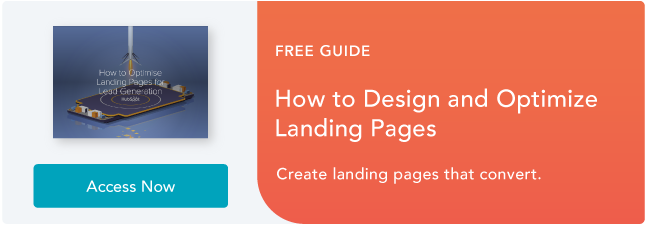
No hay comentarios:
Publicar un comentario